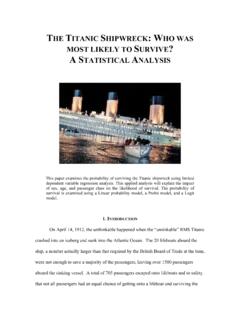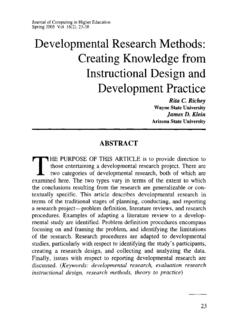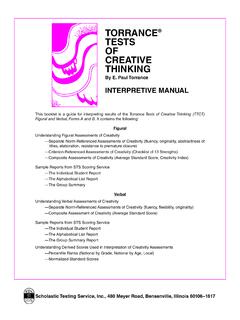Transcription of What Is Design Thinking and Why Is It Important?
1 Review of Educational Research September 2012, Vol. 82, No. 3, pp. 330 348 DOI: 2012 AERA. Is Design Thinking and Why Is It Important? Rim Razzouk, Valerie ShuteFlorida State UniversityDesign Thinking is generally defined as an analytic and creative process that engages a person in opportunities to experiment, create and prototype mod-els, gather feedback, and redesign. Several characteristics ( , visualiza-tion, creativity) that a good Design thinker should possess have been identified from the literature. The primary purpose of this article is to summarize and synthesize the research on Design Thinking to (a) better understand its char-acteristics and processes, as well as the differences between novice and expert Design thinkers, and (b) apply the findings from the literature regard-ing the application of Design Thinking to our educational system.
2 The authors overarching goal is to identify the features and characteristics of Design Thinking and discuss its importance in promoting students problem-solving skills in the 21st : Design Thinking , Design process, expertise, expert and successful in today s highly technological and globally competitive world requires a person to develop and use a different set of skills than were needed before (Shute & Becker, 2010). One of these skills is called Design Thinking . Design has been widely considered to be the central or distinguishing activity of engineering (Simon, 1996). It has also been said that engineering programs should graduate engineers who can Design effective solutions to meet social needs (Evans, McNeill, & Beakley, 1990).
3 Like problem solving, Design is a natural and ubiqui-tous human activity. Needs and dissatisfaction with the current state combined with a determination that some action must be taken to solve the problem is the start of a Design process. In this view, many scientists have been designing and acting as designers throughout their careers, albeit often not being aware of or recognizing that they are performing in a Design process (Braha & Maimon, 1997).According to Braha and Maimon (1997), engineering lacks sufficient scientific foundations. Historically, engineering curricula have been based on models that are devoted to basic science, where students apply scientific principles to techno-logical problems. However, this practice produces engineering graduates who were perceived by industry and academia as being unable to practice in industry.
4 This concern caused leaders of engineering departments and colleges to recognize Thinking and Its ImportanceRazzouk and Shute at AERA on October 2, 2012 from Design Thinking and Its Importance331the intellectual complexities and resources demanded to support good Design edu-cation (Todd & Magleby, 2004). This awareness has resulted in the improvement of existing courses to include industry-sponsored projects where companies pro-vide real problems along with real-world expertise (Bright, 1994; Dutson, Todd, Magleby, & Sorensen, 1997). Design Thinking has also started to receive increased attention in business set-tings. This is because the Design of products and services is a major component of business competitiveness, to the extent that many known companies have commit-ted themselves to becoming Design leaders (Dunne & Martin, 2006).
5 And although Design Thinking has become an integral part of the Design and engineering fields as well as business, it can also have a positive influence on 21st century education across disciplines because it involves creative Thinking in generating solutions for problems. That is, in academic environments, students are required to read criti-cally, think and reason logically, and solve complex problems (Rotherham & Willingham, 2009). Thus, to help students succeed in this interconnected, digital world we live in, educators should support students in developing and honing 21st-century skills ( , Design Thinking , systems Thinking , and teamwork skills) that enhance their problem-solving skills and prepare them for college and career (Rotherham & Willingham, 2009; Shute & Torres, 2012).
6 These skills are consistent with the theoretical traditions of situated cognition (Lave & Wenger, 1991), developmental theories (Piaget, 1972), and constructiv-ism (Bruner, 1990). What s new is the growing extent to which individual and collective success is seen as depending on having such skills. In addition to busi-ness settings, Design Thinking has received a lot of attention in engineering, archi-tecture, and Design majors in universities because it can change how people learn and solve problems ( , Dym, Agogino, Eris, Frey, & Leifer, 2005; Fricke, 1999; Nagai & Nagouchi, 2003). The topic of expertise in Design has also been receiving increasing attention in Design research. In support of these claims, consider the large number of research articles published on the topic of Design Thinking ( , Do & Gross, 2001; Goldschmidt & Weil, 1998; Owen, 2007; Stempfle & Badke-Schaube, 2002; Tang & Gero, 2001).
7 Among these research papers, there are stud-ies of expert or experienced designers and comparisons of the processes of novice versus expert designers ( , Cross & Cross, 1998; Ericsson & Smith, 1991; Ho, 2001). Within this large body of Design Thinking research, experimental and quasi-experimental studies are lacking. Most, if not all of the studies are and FocusThe dual aims of this article are to (a) summarize findings from the literature of Design Thinking to gain better understanding of its characteristics, processes, and differences between novice and expert Design thinkers and (b) apply the findings from the literature regarding Design Thinking to our educational system. Our over-arching goal is to identify the features and characteristics of Design Thinking and show its importance in promoting students problem-solving skills needed to succeed in the 21st century.
8 The major questions addressed in this review include (a) What are the characteristics of Design Thinking , (b) what are the differences between a novice and an expert Design thinker, and (c) why is Design Thinking important? at AERA on October 2, 2012 from 332 MethodMany articles in the Design Thinking literature were identified and then col-lected. Table 1 lists and describes the online databases and Web sites that were employed in this search-collection effort. The focus of the search was to access full-text documents using various search terms or keywords such as Design think-ing, Design cognition, Design behavior, Design studying, Design reasoning, Design process, Thinking of Design , visual Thinking , and prototyping. The search was not limited to a particular date range or experimental studies.
9 However, slight prefer-ence was given to more recent research. In all, approximately 150 documents were collected. From this set, a total of more than 45 documents met the criteria for inclusion in the literature review. The inclusion criteria consisted of topical rele-vancy of documents to the research questions in this article ( , Design Thinking characteristics and processes, novice vs. expert Design thinker, and the importance of Design Thinking ). Both experimental and nonexperimental studies were included in this 1 Databases used in searching for articlesDatabase and Web sitesDescriptionERICA database that provides extensive access to education-related literature from the following two printed journals: Re-sources in Education (RIE) and Current Index to Journals in Education (CIJE).
10 JSTORA database of back issues of core journals in the humanities, social sciences, and sciences. The gap between the most recently published issue of any journal and the date of the most recent issue available in JSTOR is from 2 to 5 of the largest online collections of published scientific research. It is operated by the publisher Elsevier and contains nearly 10 million articles from over 2,500 journals and over 6,000 e-books, reference works, book series, and XploreA database that indexes, abstracts, and provides full-text for articles and papers on computer science, electrical engineering, and electronics. The database mainly covers material from the Institute of Electrical and Electronics Engineers (IEEE) and the Institution of Engineering and Technology (IET).









